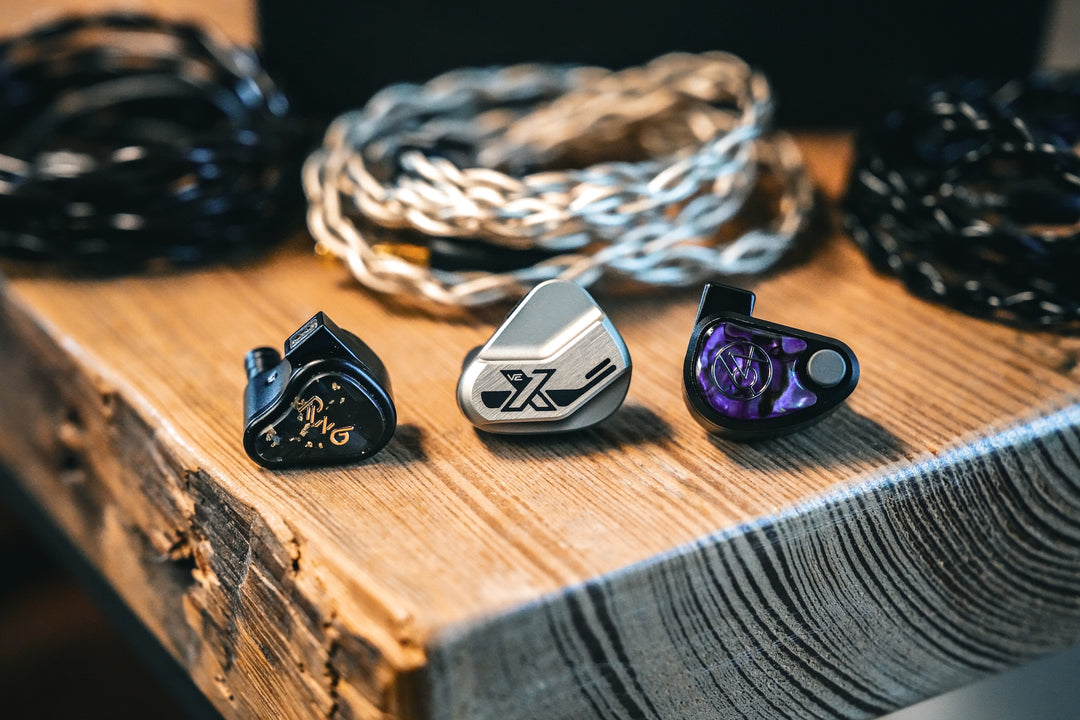ThieAudio achieved IEM superstardom with expertly tuned IEMs like the Oracle and Monarch, but they weren’t content to coast by as a one-hit-wonder. They're constantly refining their designs to achieve something new with each subsequent release. Between its price point, tuning, and overall quality, Monarch MK2 was rated as one of the best IEMs in the world by a number of reviewers and critics, leaving MK3 with some pretty big shoes to fill. Can Monarch MK3 improve upon its predecessor and take the crown as the new king of $1000 IEMs?
Build and Design
The packaging and accessory kit for Monarch MK3 remains essentially the same as the previous generation and is largely shared across ThieAudio’s lineup. Monarch MK3 has an updated cable which looks and feels more like the cable included with the Oracle MK2, but the materials and construction are different, featuring more conductive mass and a mix of silver and graphene plating on the OCC copper wire. The modular system is also really well executed, allowing you to easily swap terminations for different sources or contexts, or just not worry about immediately replacing the stock cable for a new termination if it doesn’t match your preferred source.
While the default faceplate is gorgeous, one of the big draws here is the range of visual customizations that are available. There are 7 different shell options and 16 faceplate options, but not every faceplate and shell option can be combined. The final number of possible combinations is about 80, and any one of them gives you a look that could be a flagship IEM in its own right.
Monarch MK3 is a 10-driver Tribrid, with 2 dynamic drivers using ThieAudio’s IMPACT2 tech for bass and subbass, 6 balanced armatures splitting the mids and lower treble, and 2 EST drivers for the ultra high range. It’s also surprisingly hard to drive for an IEM. The sensitivity is only 99dB while the impedance is 20 ohms. You certainly won’t need a separate amp for these, but if you were at 60% volume with your previous IEMs, you’ll probably need 70-75% with Monarch MK3.
Sound
There are a lot of well tuned IEMs out there: ones with clear and balanced tunings that add just enough emphasis in one place or another to give it a unique character. You can get IEMs like this for around $100 – maybe even less. The challenge of higher end IEMs is improving aspects like the spatial presentation, detail retrieval, and resolution without losing the core tuning balance. Monarch MK3 succeeds in both maintaining that core tuning balance, and in delivering a level of technical performance that clearly elevates it above IEMs that simply “sound good.”
The bass extension is excellent. In terms of deep rumbly visceral bass, Monarch MK3 gets about as close to a bone conduction driver as I’ve heard in a dynamic driver. The midbass delivers plenty of punch as well. Fans of pop/rock/hip-hop and most modern music genres should be more than satisfied with the low-end presentation. With genres like classic jazz, folk, and classical you get plenty of texture and character in upright basses, acoustic guitars and kick drums as well as powerful impact in your orchestral percussion. However, with folk and jazz in particular, I found the bass could overpower guitar or piano in the mix at times.
Monarch MK3 delivers on the fundamentals of balance and timbre in the midrange, providing natural, lifelike instruments and vocals. While the bass is emphasized in the mix, it doesn’t negatively impact the character or clarity of other instruments. While an upright bass on a Thelonious Monk recording might feel slightly too loud compared to the piano, the piano itself sounds clean and clear, with a natural timbre and without the bloat that can characterize more bass heavy IEMs.
Monarch MK3’s marketing makes claims of improved treble, and it backs those claims up. MK3’s treble is focused more in the upper air range, offering plenty of sizzle in your cymbals, and a resolving feeling on soprano vocals and the upper end of the orchestra. I found the treble to be largely non-fatiguing as well. It avoids most of the common painful spots, giving you sparkle and shimmer without sibilance and stabbing.
The imaging and soundstage are a clear highlight here, and another way that Monarch MK3 differentiates itself from less expensive, similarly tuned IEMs. MK3 is surprisingly wide and very three-dimensional, presenting an arena-like stage. The image is presented with strong clarity in the positioning and separation between instruments, providing a holographic experience.
The two main sources I used for my listening were the iBasso DX170 and Astell&Kern SR35. Listening with the SR35 is where I felt the low end slipping into the “too much bass” category on some tracks. With the same tracks, DX170 cleaned things up significantly, delivering an emphasized powerful bass that remains in balance with the rest of the mix.
“Pariah” is a great example of Steven Wilson’s mixing and production wizardry, and Monarch MK3 does a great job capturing the excellent dynamics and varied elements of the song. You can feel the width of MK3’s soundstage on the spacier elements in the synths, and the vocal arrangement demonstrates the highly three-dimensional presentation and holographic imaging. In comparison with the Monarch MK2, the vocals aren’t quite as vivid or forward, but they’re generally better balanced in the mix on MK3.
When I was listening to Thelonious Monk’s “Ruby My Dear,” I knew I had to try out a few different sources to get the full picture of what Monarch MK3 was doing. The SR35 was my starting point, and combined with the Monarch MK3, the tone and timbre was amazing, as well as the presentation of the band and their layout. The drums felt like-life and the piano had strong dynamics and a very tactile feeling, but certain ranges in the bass would overpower the piano in the mix. Trying a variety of sources, it seems more reference or even analytical sounding sources from Chord or iBasso really cleaned things up, and sounded excellent across the board, while warmer sources could lead to some unwanted bleed.
Monarch MK3 seems perfectly suited to deliver the wall of deep bass on Lady Gaga’s “Bad Romance;” the combination of rumble and impact feels like it’s slowly crushing your brain – but crushing it with exquisite detail and texture. The lead vocals have a just right balance in the mix, and a good sense of dynamics and vocal resolution. Each component of the layered synths and vocals is cleanly separated, resulting in a sound that’s free from congestion but feels like a perfectly orchestrated, cohesive whole.
Comparison: Monarch MK2, U4s
Monarch MK3, Monarch MK2, and the 64 Audio U4s present an interesting comparison. All three are a variation on a harman neutral sound signature intended to add a little more musicality and engagement, but all three do it in a slightly different way. In addition, they represent a range of technical performance that offers a different contrast.
For the general tuning and tonal balance, U4s adheres most strongly to the target curve, with just a little extra emphasis in the low-end. Monarch MK2 adds a little more bass and also emphasizes the upper-mid vocal range more strongly, while having more noticeable upper treble roll-off. MK3 delivers the strongest bass emphasis, but also matches the upper air in the treble of U4s.
U4s has the edge on the technical side with a sense of precision and speed, coupled with a highly three-dimensional stereo image. Monarch MK2 doesn’t have the level of resolution as U4s, and while it has a wide soundstage and very vivid vocal imaging the imaging as a whole lacks depth. Monarch MK3 is closer to U4s’s fast, resolving performance, and also makes some clear improvements in the imaging characteristics. With MK3, you get some of MK2’s width, coupled with much greater depth, a more rounded, coherent feeling presentation, and better separation.
Particularly in comparison to Monarch MK2, Monarch MK3 is bound to be controversial among IEM fans. On the one hand, aspects of the imaging have been noticeably improved, but on the other hand, the increased bass reduces versatility, and at times you might miss MK2’s more intimate vocal presentation. Between the U4s and MK3, it really just comes down to tuning preference. The technical aspects of the two are similar, but U4s delivers a more accurate reference sound, while MK3 takes the fun and musicality over neutrality.
Final Thoughts
Monarch MK3’s emphasized bass moves past Monarch MK2’s “bass-boosted neutral” signature into genuinely “basshead” territory. In many ways it reminds me of the Empire Ears Legend EVO and the Astell&Kern + Empire Ears Odyssey, both of which deliver extraordinary bass without compromising the technical aspects of the delivery and the rest of the sound signature. Whether or not you love the changes from Monarch MK2, the price, performance, and design make a really compelling case for Monarch MK3 as a near-flagship quality $1000 basshead IEM.











